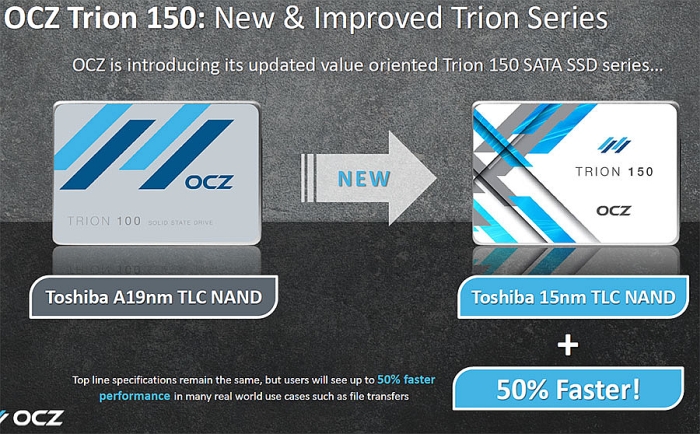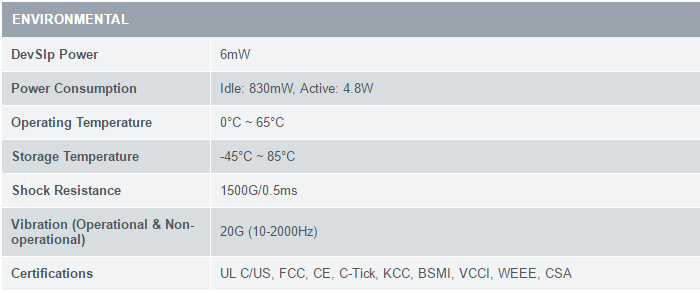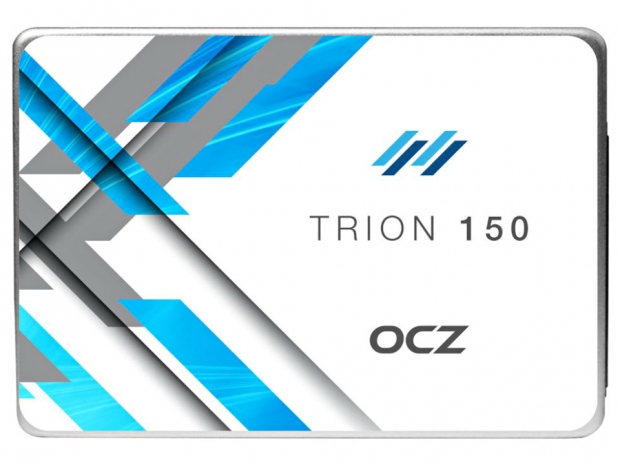Index
- OCZ Trion 150 480GB SSD Reviewed
- Performance Specifications
- Packaging
- Testing Methodology
- Benchmark Results - CrystalDiskMark x64 v5.1.2
- Benchmark Results - ATTO Disk Benchmark v3.05
- Benchmark Results – Iometer v1.1.0
- Benchmark Results – AS SSD Benchmark v.1.8.5636.37293
- Benchmark Results – PlayStation 4 SSD vs HDD
- Price-per-Gigabyte Comparison (March 28, 2016)
- Conclusion
- All Pages

Trion 150 Series – Performance Specifications
The 480GB drive we are testing features a maximum random read of 90,000 IOPS (4KB, QD32), maximum random write of 54,000 IOPS (4KB, QD32), steady-state random write of 3,200 IOPS (4KB, QD32) and endurance rating of 120TB at 110GB/day.
Here are the new OCZ Trion 150 specifications from February 2016, based on Toshiba 15nm NAND flash. The new drives come in storage capacities ranging between 120GB and 960GB and are rated between 30TB and 240TB of total disk writes over a 3-year warranty period.
Trion 150 Series – Environmental Specifications
Power specifications remain unchanged for the Trion 150 series from the previous Trion 100 lineup. OCZ is rating idle power consumption at just 830 milliwatts (mW), active power consumption at 4.8 watts (W) and DevSlp power at 6 milliwatts (mW).

DevSleep is a feature in some SATA devices that allows them to enter a low-power “device sleep” mode while remaining powered on, reducing overall power consumption by at least two orders of magnitude over normal idle power draw (e.g. from 830mW to just 6mW in this case, although some drives can get as low as 2.5mW).
Trion 100 Series – Performance Specifications
Here are the OCZ Trion 100 specifications from July 2015, based on Toshiba Advanced 19nm NAND flash. The first-generation Trion drives also came in storage capacities ranging between 120GB and 960GB and are rated between 30TB and 240TB of total disk writes over a 3-year warranty period.

Trion 100 Series – Environmental Specifications
(same as Trion 150 Series)
Hardware specifications very similar – what’s new here?
Despite the new Trion 150 series having nearly identical specs with its predecessor, OCZ’s press release states, “as the next iteration of this series, expect improved sustained performance and enhanced file transfer rates.” From the company’s official presentation slide, it is claiming up to 50 percent faster real-world performance for file transfers with its 15-nanometer TLC NAND flash over the previous Advanced 19-nanometer (A19nm) 128Gbit TLC NAND technology.
Although there is a difference in NAND flash, it appears that both lineups use the same Toshiba controller under the hood, with the newer Trion 150 lineup using a more improved firmware. The previous Trion 100 series uses a Toshiba TC58 controller and Toshiba firmware. After some investigative digging, AnandTech is claiming the Trion 100’s TC58 was based on Phison’s S10 controller because of a very similar PCB layout. One reason to support this claim is that Toshiba and Phison have had a close manufacturing relationship for years, with Toshiba having partial access to Phison’s firmware source code and Phison’s OEM drives being manufactured in Toshiba’s own factories.
In addition to utilizing Toshiba's latest 15-nanometer NAND flash, the newer Trion 150 series uses the same Toshiba TC58 controller, but now has a newer firmware. The sample we were provided came with firmware version 12.2, and this is the initial release for the Trion 150 series according to OCZ’s website.
This is the premise we are going to run with during this review.




